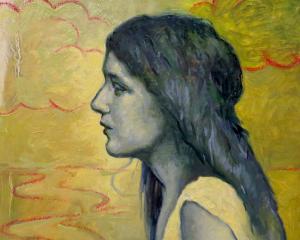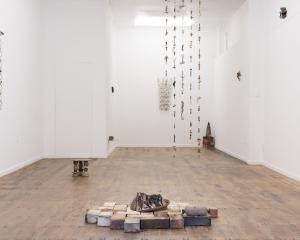"Harbour", Inge Doesburg (The Artist's Room)
Those who know Inge Doesburg's work primarily through her fine moody prints will be in for a surprise when they visit the exhibition on at The Artist's Room.
The subject matter is the same - pensive scenes of a sky that's ever falling down on a real and imagined Otago.
The manner of production of these works, however, shows another side to Doesburg's art.
Only a handful of the works on display are drypoint; many of the pieces are oil paintings, and others are mixed media or charcoal.
The works show that there is more to the artist's skills than her acknowledged fine printmaking abilities.
In the charcoal sketch Wanaka trees, gaunt branches are perfectly captured against a hazy lakescape.
More experimental pieces use paint applied directly to the printer's copper plates to produce sombre fugues of cloud.
Most astonishing of all the pieces is a giant painted panoramic view from the roof of the peninsula, the clouds dripping over the parched and yellowed land.
Inge Doesburg shows that, no matter what the medium, she has the ability to produce attractive, reflective pieces of evocative art which call to both the mind and heart.
Tony Fomison (Brett McDowell Gallery)
It is surprising that there has not been an exhibition of Tony Fomison's work in Dunedin for more than two decades.
Fomison, who died 20 years ago this year, is an acknowledged major figure of New Zealand art, and perhaps the first to successfully straddle the ethnological gap between European and Pacific Island culture.
The Brett McDowell Gallery has brought to Dunedin paintings, prints and graphite drawings by the artist showing several sides of his work.
The images are important not just for what they are, but also for the clear influencing of later New Zealand artists.
Fomison used his knowledge of archaeology and the archetypal structure of the land to good effect in his works.
The combination can be seen in the five deep monochromatic oils on display, and are also given voice in the strange symbolic lithographs.
The three drawings are of their time, and of the New Zealand art milieu of the 1960s and early 1970s when they were created - they clearly come from the same spiritual place as the contemporary works of McCahon and Harris.
It is unusual to see an exhibition dedicated to Fomison's work, and the opportunity to do so may not come again for some time.
"Surfscapes" (Green Island Gallery)
Green Island Gallery's "Surfscapes" consists of work by eight local surfers who are also artists.
Several of the names are familiar, most notably Steev Peyroux and Ollie Crooks, but the work by the remaining artists is also worthy of note.
James Kerr's work is impressive, with its boldly impressionistic colours.
The sea seems to ripple in the mix of pinks and cyans which he weaves from his brush, as do the waves in two equally attractive bright works by Ollie Crooks.
More realistic are the warm vibrant tones of Nic Reeves' paintings, which depict stylised South Pacific seafronts, with foam breaking against symbol-heavy Polynesian coasts.
Darren Tautari's work is attractive, understated, and realistic.
He nicely depicts his recognisable street and beach scenes, often by picking a feature, most obviously in the simple, effective Gulls.
His work sits opposite two excellent large pieces by Steev Peyroux depicting folded blankets of hillside lapped by coastal waters or sitting nervously under sullen skies.
Street art, unsurprisingly, makes its influence known, most obviously in a series of works by Nathan Shaw, but also in the cartoon-like surfer image of Nathan Lungley.
The exhibition is completed by a series of miniature hand-float boards, shaped and decorated in fine humour by Jayin Tzu.












